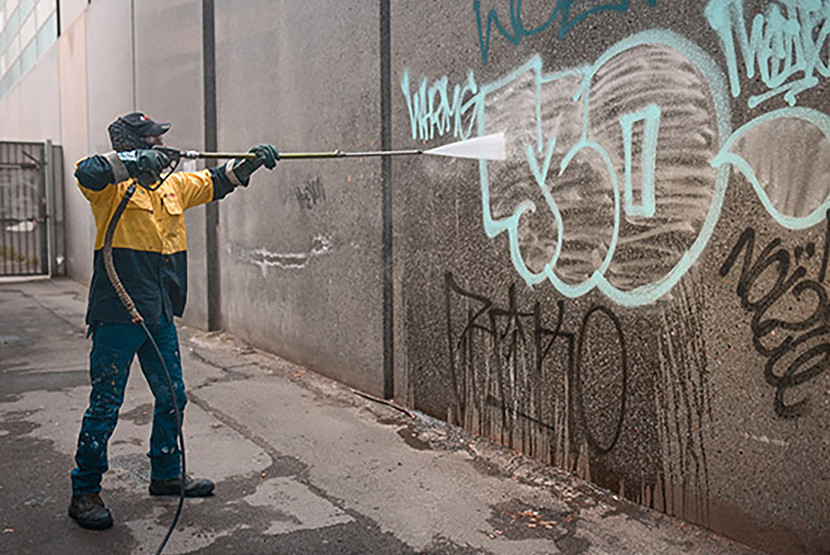
Graffiti can be a form of art — but when it’s unwanted, on your property, or done without permission, it becomes vandalism. Whether it’s a business, school, public building, or private home, graffiti can damage property value, invite more vandalism, and tarnish reputations.
Fortunately, pressure washing is one of the fastest and most effective ways to remove graffiti from many surfaces — but only when done correctly. 🧼🚫
🧪 Why Graffiti Removal Needs to Be Fast
If graffiti isn’t removed quickly, it can lead to:
- Encouraging more tagging (copycat effect)
- Loss of customers or foot traffic for businesses
- Reduced property value in residential neighborhoods
- Frustration and mistrust in schools and public spaces
Most city cleanup guidelines recommend removing graffiti within 24–48 hours to discourage recurrence.
💦 How Power Washing Removes Graffiti
Pressure washing works by blasting water at high pressure to break the bond between the paint and the surface. For porous materials like brick, concrete, or stone, this is often the most effective removal method.
When combined with the right detergents or graffiti removers, pressure washing can eliminate:
- Spray paint
- Marker ink
- Adhesive residue
- Stencils and stickers
- Paint splatters or overspray
🧼 Surface Considerations: What Works (and What Doesn’t)
| Surface Type | Power Washing Effective? | Notes |
|---|---|---|
| Brick and masonry | ✅ Yes | Use medium to high pressure with chemical assist |
| Concrete | ✅ Yes | Hot water and graffiti remover increase effectiveness |
| Stucco | ⚠️ Sometimes | Use soft wash techniques to avoid damage |
| Painted wood or siding | ⚠️ Sometimes | Risk of stripping original paint — proceed with caution |
| Glass or metal | ✅ Yes | Use lower PSI to avoid scratching |
| Plastic/vinyl signs | ❌ No | Likely to warp or discolor — better to replace |
Always test a small area first to make sure the surface won’t be damaged. 🧪
🛠️ Tools and Products Used in Graffiti Removal
To remove graffiti successfully, professionals often use:
✅ Hot water pressure washers (180–200°F)
✅ Graffiti remover or solvent-based cleaner (eco-friendly if possible)
✅ Surface cleaner attachments for even pressure
✅ Soft brushes for delicate areas
✅ Neutralizing agents to prevent ghosting (faint remnants)
Eco-conscious areas may require biodegradable cleaners that won’t harm vegetation or storm drains.
Browse Amazon Here For Top Rated Power Washers And Accessories
⚙️ Technique Tips for Best Results
- Apply cleaner and let it dwell (5–15 minutes depending on product)
- Start with low pressure and increase as needed
- Keep a consistent distance (12–18 inches is typical)
- Rinse with clean water to remove all residue
- Use circular motion for uneven surfaces like brick or stone
- Repeat if necessary — multiple passes may be needed
In some cases, the original surface may need to be repainted or sealed after graffiti removal.
🏙️ Urban Settings: Special Considerations
In cities or public areas, graffiti is often on:
- Bus stops
- School walls
- Underpasses
- Playgrounds
- Commercial storefronts
- Street signs
Cleanup here must balance efficiency with safety and legal compliance. Many municipalities offer grants, tax deductions, or free removal services for small business owners.
Always check with your local ordinance before pressure washing graffiti on city-owned property — permits may be required.
💼 Residential vs. Commercial Approach
🏠 Residential
- Typically painted siding, fences, garage doors
- Risk of surface damage — low pressure is critical
- Many homeowners prefer hiring professionals to avoid costly mistakes
🏢 Commercial/Public
- Brick, block walls, concrete — durable and ideal for power washing
- Often part of regular maintenance contracts
- Fast turnaround expected to preserve business image
♻️ Runoff and Environmental Concerns
Paint and solvents are considered pollutants — never allow them to flow into storm drains. Professionals use:
- Vacuum recovery systems
- Containment mats
- Drain blockers
- EPA-compliant cleaners
This keeps the community clean and avoids environmental violations.
📅 How Often Should You Monitor for Graffiti?
Prevention is part of the solution. Consider:
- Installing surveillance cameras
- Applying anti-graffiti coatings (clear barrier layer)
- Scheduling weekly or bi-weekly inspections
- Using motion-activated lighting around blank wall spaces
- Promoting community art murals (which are rarely tagged)
The faster you remove graffiti, the less likely it is to reappear.
✅ Final Thoughts
Graffiti removal doesn’t have to be a long, frustrating battle. With the right combination of pressure washing, safe chemicals, and professional expertise, most tags can be erased quickly and without damaging your property.
When left untreated, graffiti sends the wrong message — but when cleaned up fast, it sends a powerful one: “We care about our space.” 🎨💦
Browse Amazon Here For Top Rated Power Washers And Accessories



